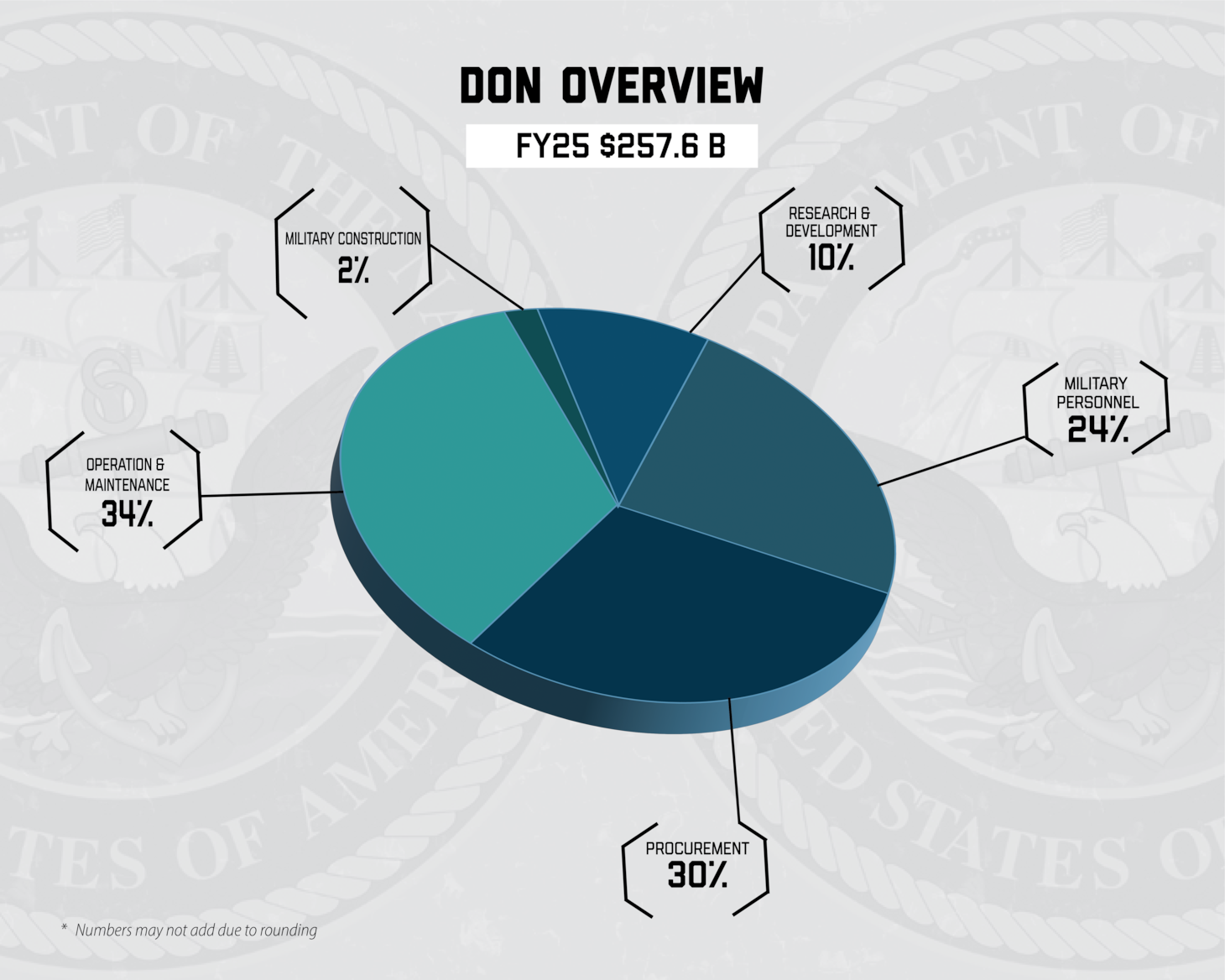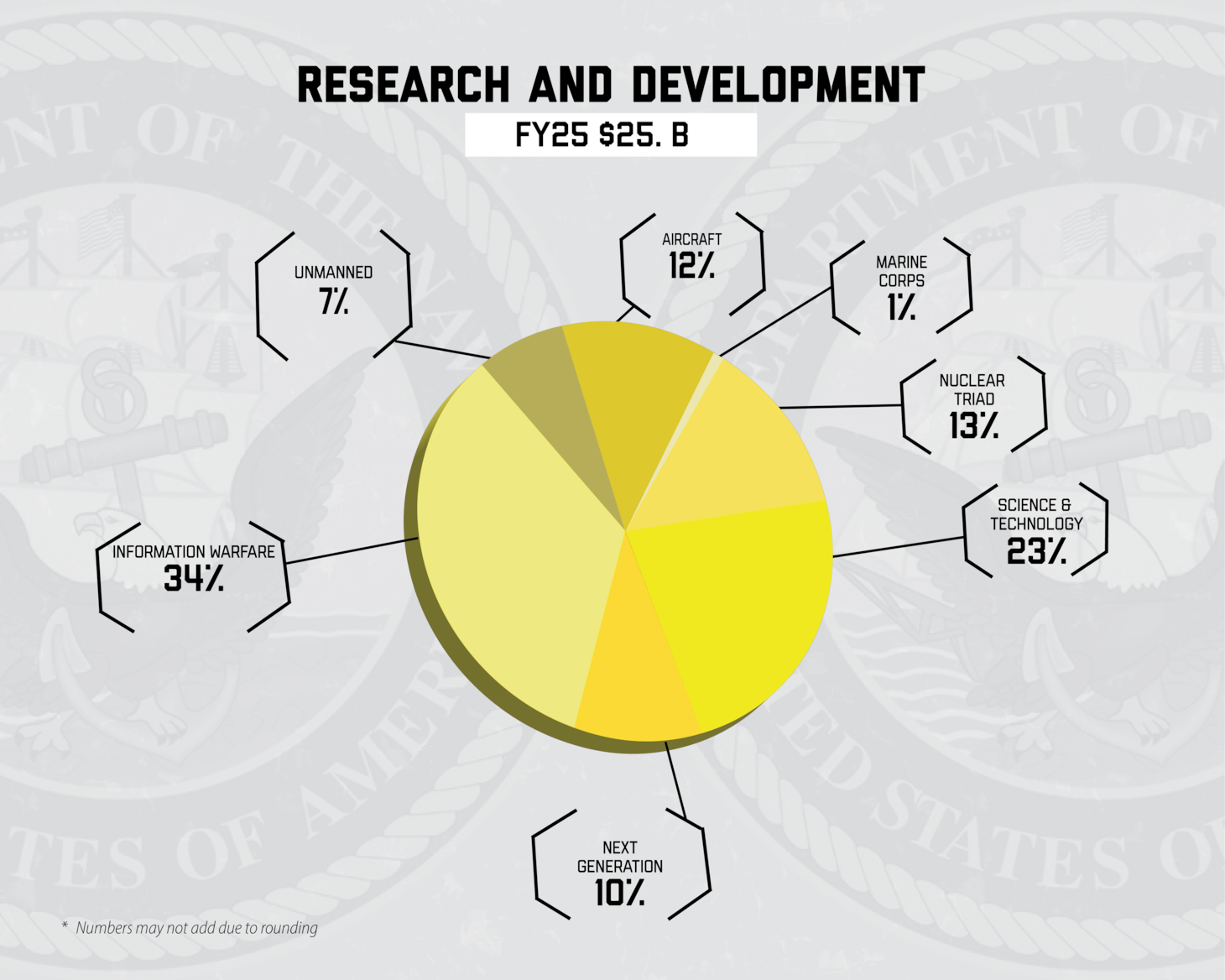The Department of the Navy's (DON) FY25 President's Budget (PB25) request is $257.6B, an increase of $1.8B or 0.7% from the FY24 President's Budget request.
The PB25 request reflects the nation's priorities as detailed in U.S. strategic guidance. At the top of this hierarchy is the President's National Security Strategy followed by the 2022 National Defense Strategy. Our request supports the tenets of our national defense that are integrated deterrence, campaigning, and actions that build enduring advantages. Secretary Del Toro's strategic guidance solidifies we are One Navy-Marine Corps Team, and remains fully nested within the National Defense Strategy. The Secretary re-emphasizes three enduring priorities: strengthen maritime dominance, build a culture of warfighting excellence, and enhance strategic partnerships with an addition of new maritime statecraft to prevail in this era of intense strategic competition.

Our request prioritizes readiness and people in a constrained topline. The DON strategically allocates resources to our operations and readiness accounts to position the Nation's Naval Force forward in defense of our interests today. It enables our Naval and Marine forces to respond to contingencies, enhance interoperability with allied navies, and adapt to the emerging threats and opportunities in the maritime domain. Our request continues to show we are developing strong warfighting teams, recruiting/retaining talented people, and ensuring our quality of service meets the highest standards.
Aligned with Secretary Austin's three priorities, our request demonstrates the Department's commitment to providing a ready, modernized, and capable naval force continues to be the nation's primary instrument of sea control both now and into the future.

For ship construction, the Department requests to procure an additional six battle force ships: one Virginia-class submarine, two Arleigh Burke-class destroyers, one Constellation-class guided-missile frigate, one San Antonio-class amphibious transport dock, and one medium landing ship.
The request continues incremental funding for the third Ford-class carrier, USS Enterprise (CVN 80), and fourth Ford-class carrier, USS Doris Miller (CVN 81). The Department continues funding of the second Columbia-class submarine and advanced procurement for ten remaining ships
For aircraft procurement, the PB25 request of $16.2 billion supports the procurement of 75 aircraft, including 26 F-35, 27 Multi-Engine Training System, 19 CH-53K, three MQ-25, as well as modification, spares, and support equipment. This request completes aircraft procurement of 27 Multi-Engine Training System in FY25 and 367 over the FYDP.

The DON's FY25 Research and Development budget supports the DON future force by funding efforts and supporting capabilities across the spectrum of conflict. R&D continues investments in developing and deploying tomorrow's capabilities across the spectrum of conflict including the generational recapitalization of all sea-based portions of the nuclear triad, SSN (X), DDG (X) unmanned vehicles, and Joint Strike Fighter. Science and technology research is vital to provide for future technologies supporting innovative capabilities in shipbuilding, aviation, weapons, and expeditionary equipment.
The budget request continues the USMC Force Design transformation effort designed to make the Marine Corps lighter, more versatile, and more lethal. This includes the development of Amphibious Combat Vehicle, Marine Air Defense Integrated System, and Ground/Air Task Oriented Radar.

The FY25 budget request of $4.6 billion finances 20 military construction baseline projects in support of the Department's critical goals. Of these, four are for naval shipyards, three are for replacing aging infrastructure, and 13 are for new platform and mission support. Installations and facilities support receive $15.7 billion across the Department. Planning and design is budgeted for future barracks and childcare projects.
This budget reflects a large investment in the health and supply chain of the industrial base, including the investment of $3.9 billion in FY25, and $11.1 billion across the FYDP for the Submarine Industrial Base, $227million into the weapons industrial base and $407 million in fleet readiness centers infrastructure modernization and optimization. The Department's Shipyard Infrastructure Optimization Program will deliver efficient and modernized shipyards by upgrading existing dry docks and building new ones, reimaging the physical layout of the shipyards, and replacing antiquated capital equipment with modern machines with an investment of $2.8 billion.
The Department funds ship operations to ensure full Fleet capability with necessary spare parts and supports training and deployment costs, including 58 underway days per quarter for deployed forces and 875,000 flying hours for Navy and Marine Corps. Ship maintenance increases by $600M, funding 58 availabilities and boosting aviation maintenance for mission capable aircraft. Field logistics receives a $112.5M investment for upgrades, while the budget streamlines Marine Littoral Regiment transformation and supports Indo-Pacific exercises with a $29.9M allocation for advanced maintenance techniques and radar integration. PB25 prioritizes the readiness of ships, aircraft, and weapons in support of the warfighter.
For FY25 Military Personnel, the budget request funds an active duty end strength of 332,300 Navy and 172,300 Marine Corps Personnel while also funding 57,700 Navy reserve personnel and a Marine Corps Selected Reserve end strength of 34,500. Basic pay increases by 4.5% and the income eligibility threshold for Basic Needs Allowance rises from 150% to 200% of the federal poverty guidelines. Recruitment and retention efforts are intensified with funding for enlistment and re-enlistment bonuses increasing by $84M or 8.5%. Quality of Life initiatives focus on improving unaccompanied housing and food options for Sailors assigned to ships undergoing maintenance, alongside significant investments in childcare centers and professional development opportunities. Funding is also allocated to expand the Naval Community College and fully fund Tuition Assistance programs, ensuring the wholeness of Naval University Systems. Sailor safety is prioritized with increased funding for Mental Health & Suicide Prevention services and continued commitment to Sexual Assault Prevention and Response Independent Review Commission.
The Department's FY25 budget request was a collaborative, strategy-driven approach maximizing the resources available. This request represents the best mix of readiness for today, modernization for tomorrow, and investment in the future - while prioritizing our Sailors, Marines, civilians and families, and strengthening relationships with our allies and partners. The DON is committed to strengthening maritime dominance, building a culture of warfighting excellence and enhancing strategic partnership-all priorities outlined in this budget.






